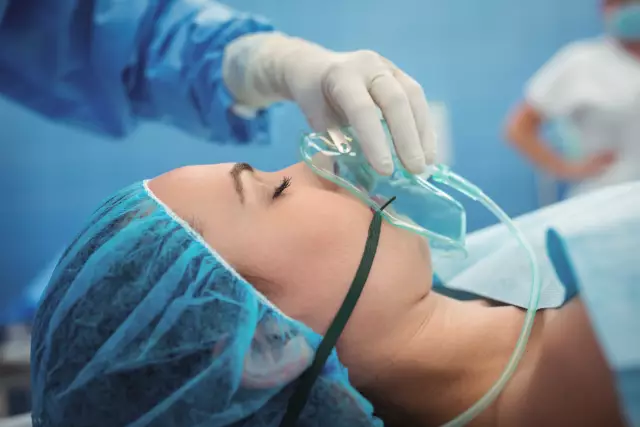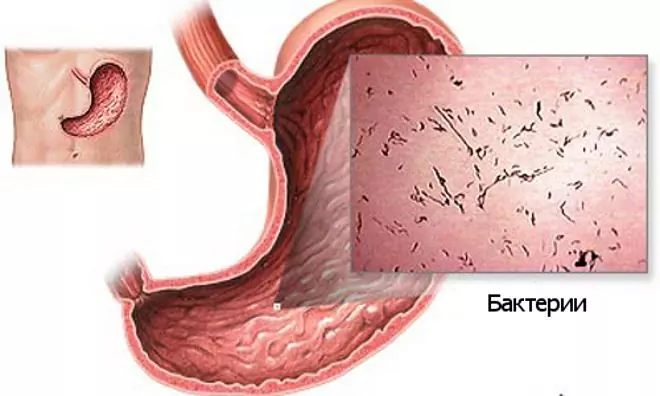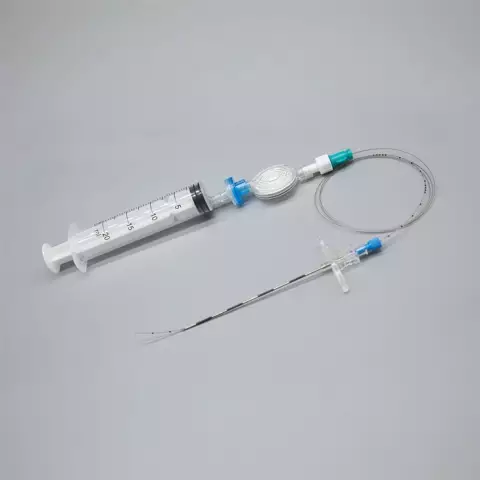- Author Rachel Wainwright [email protected].
- Public 2023-12-15 07:39.
- Last modified 2025-11-02 20:14.
Sevoran
Sevoran: instructions for use and reviews
- 1. Release form and composition
- 2. Pharmacological properties
- 3. Indications for use
- 4. Contraindications
- 5. Method of application and dosage
- 6. Side effects
- 7. Overdose
- 8. Special instructions
- 9. Application during pregnancy and lactation
- 10. Use in childhood
- 11. Drug interactions
- 12. Analogs
- 13. Terms and conditions of storage
- 14. Terms of dispensing from pharmacies
- 15. Reviews
- 16. Price in pharmacies
Latin name: Sevorane
ATX code: N01AB08
Active ingredient: sevoflurane (sevofluranum)
Manufacturer: Abbott Laboratories (UK)
Description and photo update: 2019-14-08
Prices in pharmacies: from 10,400 rubles.
Buy

Sevoran is a drug for inhalation anesthesia.
Release form and composition
Sevoran is produced in the form of a liquid for inhalation: transparent, colorless, easily mobile (100 ml each in dark colored polyethylene naphthalate bottles, one bottle in a cardboard box, six bottles in a cardboard box; 250 ml each in dark colored polyethylene naphthalate bottles), in a cardboard box one bottle, in a cardboard box six bottles).
Active ingredient: sevoflurane, in 1 bottle - 100 or 250 ml.
Pharmacological properties
Pharmacodynamics
The use of sevoflurane allows you to quickly enter the patient into a state of anesthesia and provides a way out of it. The depth of anesthesia can vary rapidly depending on changes in the content of the substance in the inhaled mixture.
With the induction of anesthesia with this drug, minimal symptoms of irritation of the upper respiratory tract or mild arousal are observed, however, sevoflurane does not provoke stimulation of the central nervous system and excessive secretion in the tracheobronchial tree.
Like other effective agents used in inhalation anesthesia, sevoflurane causes a decrease in blood pressure and respiratory depression, which is dose-dependent. Studies of Sevoran anesthesia in children confirm that the use of the drug for mask induction of anesthesia is statistically less likely to be accompanied by a cough than with the use of halothane. Under anesthesia with sevoflurane, the threshold of the arrhythmogenic effect of epinephrine is identical to that with isoflurane and higher than with halothane. When isoflurane and sevoflurane are used, myocardial ischemia and myocardial infarction in patients with factors of increased risk of developing these diseases are equally common.
The effect of isoflurane and sevoflurane on blood circulation in the brain (cerebral perfusion pressure, intracranial pressure, cerebral oxygen metabolism, cerebral blood flow) is also almost the same. Sevoflurane has a minimal effect on intracranial pressure and does not suppress the response to CO2. Also, the substance does not change the concentration function of the kidneys, even with prolonged anesthesia (up to 9 hours).
The minimum alveolar concentration (MAC, the concentration at which 50% of patients do not show a motor response to a single irritation, for example, an incision in the skin) of sevoflurane in oxygen is 2.05% in a person aged 40 years. This indicator of Sevoran, like that of other halogenated agents for inhalation anesthesia, decreases with the age of the patient and when mixing sevoflurane with dinitrogen oxide.
Pharmacokinetics
Sevoflurane is insignificantly soluble in the blood, which leads to a rapid increase in alveolar concentration when administered under general anesthesia and a rapid decrease after the completion of inhalation. 30 minutes after the inhalation of Sevoran, the ratio of the alveolar concentration at the end of inhalation and the concentration in the mixture prepared for inhalation reaches 0.85. During the elimination phase, the ratio of alveolar concentrations after 5 minutes was 0.15.
Since sevoflurane is rapidly cleared from the lungs, its involvement in metabolic processes is minimized. In humans, less than 5% of the absorbed dose of Sevoran is metabolized with the participation of cytochrome P 450 (isoenzyme CYP2E1) to form hexafluoroisopropanol. Moreover, this process is accompanied by the release of carbon dioxide and inorganic fluorine (or one carbon dioxide). Hexafluoroisopropanol does not exhibit pharmacological activity and genotoxic properties, quickly reacts with glucuronic acid and is excreted in the urine. Its toxicity is comparable to that of sevoflurane. Other metabolic pathways of the active component of Sevoran have not been identified. Sevoflurane is considered the only fluorinated volatile anesthetic agent that is not metabolized to trifluoroacetic acid.
The content of fluoride ions is determined by the duration of general anesthesia, the composition of the mixture for anesthesia and the concentration of the administered sevoflurane. The use of barbiturates does not cause defluorination of sevoflurane. Approximately 7% of adult patients in whom the level of inorganic fluoride was determined in clinical studies, its concentration exceeded 50 μmol / L. None of the subjects showed clinically significant changes in renal function.
Indications for use
According to the instructions, Sevoran is used in adult patients and children for induction and maintenance of general anesthesia during surgical operations in inpatient and outpatient settings.
Contraindications
Absolute:
- suspected or confirmed genetic susceptibility to malignant hyperthermia;
- period of breastfeeding;
- hypersensitivity to sevoflurane, as well as other halogenated drugs.
Relative (Sevoran is used with caution):
- cardiac ischemia;
- renal failure;
- impaired liver function;
- increased intracranial pressure;
- history of pirouette-type tachycardia;
- tendency to lengthen the QT interval;
- mitochondrial diseases;
- tendency to seizures;
- neuromuscular diseases;
- use in obstetric operations in gynecological practice;
- concomitant use of drugs that cause or can cause impaired hepatic function.
Instructions for the use of Sevoran: method and dosage
The drug is intended for inhalation use with a vaporizer specially calibrated for sevoflurane.
For introduction into general anesthesia, the dose of Sevoran is selected and titrated individually for each patient until the desired effect is achieved, taking into account the patient's condition and age. After inhalation of the drug, any short-acting barbiturate or other agent for intravenous induction of general anesthesia can be administered. For the introduction of anesthesia, Sevoran is allowed to be used in a mixture of nitric oxide and oxygen or in pure oxygen.
Introduction to general anesthesia before surgery is provided for less than 2 minutes with inhalation of the drug at a concentration of up to 8%.
To maintain general anesthesia, Sevoran inhalation is used at a concentration of 0.5-3%, together with nitric oxide or without it. The MAC value (minimum alveolar concentration) depends on the patient's age and the method of administration of sevoflurane (in oxygen or in a mixture of oxygen and nitric oxide).
Patients generally recover quickly from general anesthesia with Sevoran, so postoperative analgesia may be required earlier.
Side effects
Most of the side effects that occur with Sevoran inhalation are mild to moderate and go away on their own. In clinical studies and post-marketing observations, the following adverse reactions have been reported:
- digestive system: very often - vomiting and nausea; often - increased salivation; frequency unknown - jaundice, liver failure, pancreatitis, hepatitis, liver necrosis;
- respiratory system: very often - cough; often - laryngospasm, breath holding, respiratory distress, airway obstruction; infrequently - bronchospasm, apnea, hypoxia; frequency unknown - wheezing, shortness of breath, respiratory depression;
- cardiovascular system: very often - lowering blood pressure, bradycardia; often - increased blood pressure, tachycardia; infrequently - complete atrioventricular block, atrial arrhythmia, syncope, ventricular and supraventricular extrasystoles, arrhythmia, atrial fibrillation, II degree atrioventricular block, bigeminia, bleeding, ST segment depression, T wave inversion; frequency unknown - ventricular fibrillation, cardiac arrest, prolongation of the QT interval;
- nervous system and psyche: very often - agitation; often - headache, dizziness, drowsiness; infrequently - confusion of consciousness; the frequency is unknown - increased intracranial pressure, dystonia, convulsions;
- musculoskeletal system: frequency unknown - muscle rigidity;
- skin and subcutaneous tissues: frequency unknown - urticaria, contact dermatitis, rash, itching, swelling of the face;
- metabolism and nutrition: frequency unknown - hypercreatininemia, hyperkalemia;
- urinary system: frequency unknown - tubular interstitial nephritis;
- immune system: frequency unknown - anaphylactic and pseudo-anaphylactic reactions, hypersensitivity reactions;
- laboratory indicators: often - a change in the number of leukocytes, a change in glucose concentration, a transient increase in the concentration of fluorides, transient abnormalities in liver function indicators; the frequency is unknown - an increase in the plasma concentration of phosphorus;
- other reactions: often - fever, chills, hypothermia; frequency unknown - chest discomfort, malignant hyperthermia.
Overdose
In case of an overdose of Sevoran, the drug must be stopped immediately. It is also recommended to start controlled or assisted ventilation of the lungs, accompanied by the introduction of oxygen, to ensure airway patency and maintain a stable cardiovascular system.
special instructions
Sevoran can only be used by anesthesiologists who have received appropriate training in general anesthesia.
During inhalation, it is necessary to monitor blood pressure, electrocardiogram, oxygen saturation and partial pressure of carbon dioxide at the end of exhalation. Additional supervision is also required after coming out of anesthesia before being transferred to a specialized department.
After the cessation of sevoflurane supply, consciousness is restored within a few minutes. There may be a slight change in mood for 2-3 days after general anesthesia. Patients should be informed that after general anesthesia, the ability to perform work requiring special attention and quick response may deteriorate. The question of the timing of the resumption of such activities is decided by the anesthesiologist.
Application during pregnancy and lactation
The results of reproductive studies on animals indicate that the administration of Sevoran in doses not exceeding 1 MAC did not have a negative effect on reproductive function and did not contribute to the occurrence of fetal malformations.
Studies of the effects of the drug on pregnant women have not been conducted. During pregnancy, Sevoran can be used only in cases where the intended benefits to the mother significantly outweigh the potential risks to the fetus.
Since there is no information on the elimination of sevoflurane in breast milk, during lactation, patients are advised to refrain from breastfeeding while using this drug for anesthesia and for 48 hours after its use.
Experiments have convincingly confirmed the safety of Sevoran for mother and newborn when used for general anesthesia during a caesarean section. The safety of the drug during labor and after the onset of labor through the vaginal birth canal is not precisely defined. Sevoflurane helps to relax the muscles of the uterus, which is believed to increase the potential risk of uterine bleeding. In obstetric operations, Sevoran must be used with caution.
Pediatric use
In isolated cases, the use of Sevoran anesthesia in children led to an increase in the concentration of potassium in the blood serum, which contributed to the development of cardiac arrhythmias and death in the postoperative period. Patients with latent or pronounced neurological disorders, in particular patients with Duchenne muscular dystrophy, are especially susceptible to such conditions.
Drug interactions
Sevoran is combined with many drugs used in surgical practice, including antimicrobial agents, muscle relaxants, cardiovascular agents and blood products, hormones and their synthetic analogs and agents that affect the functions of the autonomic and central nervous system.
Sevoflurane is compatible with opioid analgesics, barbiturates and benzodiazepines (opioid analgesics and benzodiazepines are believed to reduce the MAC of sevoflurane).
Nitric oxide reduces the MAC of sevoflurane.
Sevoran affects the intensity and duration of neuromuscular blockade, which is caused by non-depolarizing muscle relaxants, therefore, when these drugs are prescribed together with sevoflurane, their dose must be adjusted.
There are no data on the pharmaceutical incompatibility of Sevoran with other drugs.
Analogs
Chloroform and Ftorotan are analogues of Sevoran.
Terms and conditions of storage
Store at a temperature of 15-30 ° C out of reach of children.
The shelf life is 3 years.
Terms of dispensing from pharmacies
Prescription exclusively for hospitals.
Reviews about Sevoran
According to most reviews, Sevoran is widely used by anesthesiologists in both children and adult patients. Many experts argue that the drug is easier to tolerate than its counterparts, has fewer side reactions and does not lead to long-term negative health effects. Sevoran is rarely used on its own, most often at various stages of introduction into anesthesia, the drugs are changed several times, which guarantees the most effective anesthesia.
In pediatric practice, the advantage of Sevoran is the absence of a specific smell in the mask, which can provoke a negative reaction in children and complicate the introduction of anesthesia. Mostly, positive reviews about the drug, which is considered one of the best in its class, prevail.
Price for Sevoran in pharmacies
The approximate price for Sevoran is 9890‒10 085 rubles (for a 250 ml bottle). The drug is not available for sale in 100 ml vials.
Sevoran: prices in online pharmacies
|
Drug name Price Pharmacy |
|
Sevoran liquid for inhalation 250 ml 1 pc. RUB 10,400 Buy |

Anna Kozlova Medical journalist About the author
Education: Rostov State Medical University, specialty "General Medicine".
Information about the drug is generalized, provided for informational purposes only and does not replace the official instructions. Self-medication is hazardous to health!






